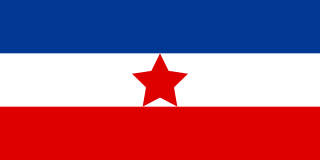 W
WDemocratic Federal Yugoslavia, also known as Democratic Federative Yugoslavia, was a provisional state established during World War II on 29 November 1943 through the Second Session of the Anti-Fascist Council for the National Liberation of Yugoslavia (AVNOJ). The National Committee for the Liberation of Yugoslavia (NKOJ) was its original executive body. Throughout its existence it was governed by Marshal Josip Broz Tito as prime minister.
 W
WThe Socialist Federal Republic of Yugoslavia, commonly referred to as SFR Yugoslavia or simply Yugoslavia, was a country in Southeast and Central Europe that existed from its foundation in the aftermath of World War II until its dissolution in 1992 amid the Yugoslav Wars. Covering an area of 255,804 km2, the SFRY was bordered by the Adriatic Sea and Italy to the west, Austria and Hungary to the north, Bulgaria and Romania to the east, and Albania and Greece to the south. The nation was a socialist state and a federation governed by the League of Communists of Yugoslavia and made up of six socialist republics – Bosnia and Herzegovina, Croatia, Macedonia, Montenegro, Serbia, and Slovenia – with Belgrade as its capital. In addition, it included two autonomous provinces within Serbia: Kosovo and Vojvodina. The SFRY's origin is traced to 26 November 1942, when the Anti-Fascist Council for the National Liberation of Yugoslavia was formed during World War II.
 W
WThe 5th Congress of the Communist Party of Yugoslavia was held from 21 to 28 July 1948, in the House of the Guard in Topčider, Belgrade. The Congress was attended by 2,344 delegates out of the 468,175 members of the Communist Party of Yugoslavia.
 W
WThe 6th Congress of the Communist Party of Yugoslavia was held from 2 to 7 November 1952, in Zagreb. The Congress was attended by 2,022 delegates who represented 779,382 members of the Communist Party of Yugoslavia. Beside the elected delegates, the Congress was attended by around 400 guests – political, social and public workers from the whole Federative People's Republic of Yugoslavia, as well as delegation of foreign communist and socialist parties.
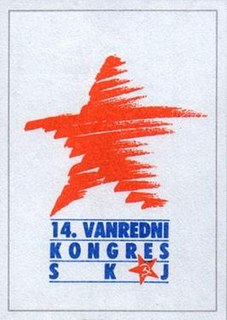 W
WThe 14th (Extraordinary) Congress of the League of Communists of Yugoslavia was held from the 20th to the 22nd of January 1990, in the Belgrade Sava Centar. The highest organ of both the government and the party, it was the last Congress of the League of Communists of Yugoslavia. It was attended by delegates from all the republics and provinces, as well as a party delegation from the Yugoslav People's Army. The meeting was chaired by President of the Presidium of the Central Committee Milan Pančevski from Macedonia.
 W
WBrotherhood and Unity was a popular slogan of the League of Communists of Yugoslavia that was coined during the Yugoslav People's Liberation War (1941–45), and which evolved into a guiding principle of Yugoslavia's post-war inter-ethnic policy. In Slovenia, the slogan "Brotherhood and Peace" was used in the beginning.
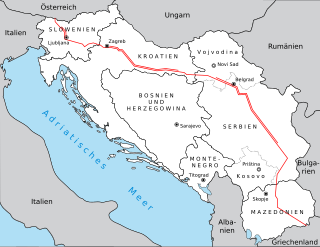 W
WThe Brotherhood and Unity Highway, officially classed as the M-1 Highway, was a highway that stretched over 1,182 km (734 mi) across Yugoslavia, from the Austrian border at Rateče near Kranjska Gora in the northwest via Ljubljana, Zagreb, Belgrade and Skopje to Gevgelija on the Greek border in the southeast. It was the main modern highway in the country, connecting four constituent republics and the country as a whole with neighboring highways.
 W
WThe Croatian Spring was a cultural and political movement that emerged from the League of Communists of Croatia in the late 1960s which opposed the unitarization and called for economic, cultural and political reforms in SFR Yugoslavia including higher autonomy and more self governing rights for SR Croatia within Yugoslavia. In 1971, the Yugoslav authorities suppressed the movement by force.
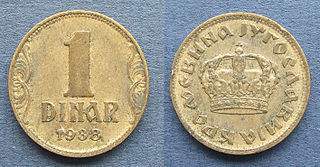 W
WThe dinar was the currency of the three Yugoslav states: the Kingdom of Yugoslavia, the Socialist Federal Republic of Yugoslavia, and the Federal Republic of Yugoslavia between 1918 and 2006. The dinar was subdivided into 100 para. In the early 1990s, economic mismanagement made the government bankrupt and forced it to take money from the savings of the country's citizens. This caused severe and prolonged hyperinflation, which has been described as the worst in history. Large amounts of money were printed, with coins becoming redundant and inflation rates reaching over one billion per cent per year. This hyperinflation caused five revaluations between 1990 and 1994; in total there were eight distinct dinari. Six of the eight have been given distinguishing names and separate ISO 4217 codes. The highest denomination banknote was 500 billion dinars, which became worthless a fortnight after it was printed.
 W
WThe emblem of Yugoslavia featured six torches, surrounded by wheat with a red star at its top, and burning together in one flame; this represented the brotherhood and unity of the six federal republics forming Yugoslavia: Bosnia and Herzegovina, Croatia, Macedonia, Montenegro, Serbia and Slovenia. The date imprinted was 29 November 1943, the day the Anti-Fascist Council for the National Liberation of Yugoslavia (AVNOJ) met in Jajce on its second meeting and formed the basis for post-war organisation of the country, establishing a federal republic. This day was celebrated as Republic Day after the establishment of the republic. The emblem of Yugoslavia, along with those of its constituent republics, are an example of socialist heraldry.
 W
WThe Gazimestan speech was given on 28 June 1989 by Slobodan Milošević, then president of Serbia, at the Gazimestan monument on the Kosovo field. It was the centrepiece of a day-long event to mark the 600th anniversary of the Battle of Kosovo, which was fought at the site in 1389.
 W
W"Hey, Slavs" is a patriotic song dedicated to the Slavic peoples which was used as the national anthem of various countries during the 20th century.
 W
WThe Socialist Federal Republic of Yugoslavia (SFRY) was a socialist country that existed in the second half of the 20th century. Being socialist meant that strict technology import rules and regulations shaped the development of computer history in the country, unlike in the Western world. However, since it was a non-aligned country, it had no ties to the Soviet Bloc either. One of the major ideas contributing to the development of any technology in SFRY was the apparent need to be independent of foreign suppliers for spare parts, fueling domestic computer development.
 W
WInformbiro was a period in the history of Yugoslavia which spanned from 1948 to 1955, characterised by conflict and schism with the Soviet Union. The word Informbiro is the Yugoslav name for the Cominform, an abbreviation for "Information Bureau," from "Communist Information Bureau".
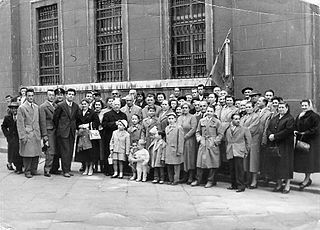 W
WThe term Istrian-Dalmatian exodus refers to the post-World War II expulsion and departure of ethnic Italians from the Yugoslav territory of Istria, as well as the cities of Zadar and Rijeka. Istria, Rijeka, and Zadar were ethnically mixed, with long-established historic Croatian, Italian, and Slovene communities. After World War I, the Kingdom of Italy annexed Istria, Rijeka, and parts of Dalmatia including Zadar. At the end of World War II, under the Allies' Treaty of peace with Italy, the former Italian territories in Istria and Dalmatia were assigned to the new nation of Yugoslavia, except for the Province of Trieste. The former territories absorbed into Yugoslavia are part of present-day Croatia and Slovenia.
 W
WHouse of Flowers is the resting place of Josip Broz Tito (1892–1980), the President of the Socialist Federal Republic of Yugoslavia, and his third wife Jovanka Broz (1924–2013). It is located on the grounds of the Museum of Yugoslav History in Dedinje, Belgrade, Serbia.
 W
WDuring Josip Broz Tito's presidency and in the years following his death in 1980, several places in the Socialist Federal Republic of Yugoslavia and across the world were named or renamed in honor of him as part of his cult of personality. Since the breakup of Yugoslavia, several towns and squares in the former nation have reverted their names. Numerous streets were also named after Tito, both in former Yugoslavia as well as elsewhere as an honour to a foreign dignitary.
 W
WThis article lists the members of the Presidency of Yugoslavia, the collective head of state of the Socialist Federal Republic of Yugoslavia from 1971 until the country's dissolution in 1991/92.
 W
WThe Militia of SFR Yugoslavia was a law enforcement agency of the Socialist Federal Republic of Yugoslavia from 1944 to 1992. The Militia was subordinated to the Federal Secretariat of Internal Affairs.
 W
WThe Museum of Yugoslavia is a public history museum in Belgrade, the capital of Serbia. It chronicles the period of Kingdom of Yugoslavia and Socialist Yugoslavia as well as the life of Josip Broz Tito. Tito's grave is located in one of the Museum buildings.
 W
WYugo-nostalgia is a less-studied psychological and cultural phenomenon found among the populations of the former Yugoslavia, in the present-day Bosnia and Herzegovina, Croatia, Montenegro, North Macedonia, Serbia, and Slovenia. When used unironically, it refers to an emotional longing for a time past when the splintered states were a part of one country, a grief about the war that tore it apart, and a desire to again unite. Self-described "Yugonostalgics" may assert their grief that brotherly love, unity, and coexistence failed, while division and nationalism won, or they may assert that their quality of life was better.
 W
WThe Order of Bravery was a Yugoslav gallantry medal, the twenty-third overall Yugoslav decoration.
 W
WThe Order of the People's Hero or the Order of the National Hero Serbo-Croatian: Orden narodnog heroja / Oрден народног хероја; Slovene: Red narodnega heroja, Macedonian: Oрден на народен херој, romanized: Orden na naroden heroj), was a Yugoslav gallantry medal, the second highest military award, and third overall Yugoslav decoration. It was awarded to individuals, military units, political and other organisations who distinguished themselves by extraordinary heroic deeds during war and in peacetime. The recipients were thereafter known as People's Heroes of Yugoslavia or National Heroes of Yugoslavia. The vast majority was awarded to partisans for actions during the Second World War. A total of 1,322 awards were awarded in Yugoslavia, and 19 were awarded to the foreigners.
 W
WOrders, decorations, and medals of the Socialist Federal Republic of Yugoslavia were created during the Second World War and used throughout the existence of the Socialist Federal Republic of Yugoslavia. The first decorations were created on March 15, 1943 and included the Order of the People's Hero, Order of the People's Liberation, Order of the Partisan Star, Order of the Brotherhood and Unity, Order for Bravery and Medal for Bravery. By 1960 the total number of decorations increased to 42 and consisted of 35 orders, 6 medals and 1 commemorative medal. The designers of the Yugoslav orders and medals were Antun Augustinčić and Đorđe Andrejević Kun.
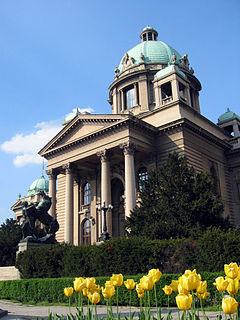 W
WThe Parliament of Yugoslavia was the deliberative body of Yugoslavia. Before World War II in the Kingdom of Yugoslavia it was known as the National Assembly, while in the Socialist Federal Republic of Yugoslavia the name was changed to Federal Assembly. It was the official deliberative body of the Yugoslav state, which existed from 1918 to 1992 and resided in the building which now convenes the National Assembly of Serbia.
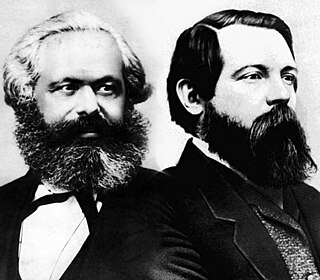 W
WThe Praxis school was a Marxist humanist philosophical movement, whose members were influenced by Western Marxism. It originated in Zagreb and Belgrade in the SFR Yugoslavia, during the 1960s.
 W
WThe Presidency of the Socialist Federal Republic of Yugoslavia, also known as the Presidium, was the collective head of state of the Socialist Federal Republic of Yugoslavia. It was established in 1971 according to amendments to the 1963 Constitution and reorganized by the 1974 Constitution. Up to 1974, the Presidency had 23 members – three from each republic, two from each autonomous province and President Josip Broz Tito. In 1974 the Presidency was reduced to 9 members – one from each republic and autonomous province and, until 1988, President of the League of Communists of Yugoslavia ex officio.
 W
WThe office of the President of the Presidency of the Socialist Federal Republic of Yugoslavia existed from the death of the President of the Republic for life Josip Broz Tito on 4 May 1980 until the dissolution of the country by 1992.
 W
WThe president of the Socialist Federal Republic of Yugoslavia, or the president of the Republic for short, was the head of state of that country from 14 January 1953 to 4 May 1980. Josip Broz Tito was the only person to occupy the office. Broz was also concurrently President of the League of Communists of Yugoslavia. Broz was eventually declared president for life and with his death in 1980 the office was discontinued and the new office of President of the Presidency of Yugoslavia took its place.
 W
WAlija Sirotanović was a Yugoslav miner, Hero of Socialist Labour and perhaps the most famous of all Yugoslav udarniks. He was held up by the Communist Party of Yugoslavia to be a model of a hard-worker in the former Yugoslavia.
 W
WThe 1972 Yugoslav smallpox outbreak was the last major outbreak of smallpox in Europe. It was centered in SAP Kosovo and Belgrade, a province and the capital city respectively of the SFR Yugoslavia. A Muslim pilgrim had contracted the smallpox virus in the Middle East. Upon returning to his home in Kosovo, he started the epidemic in which 175 people were infected, killing 35. The epidemic was efficiently contained by enforced quarantine and mass vaccination. The 1982 film Variola Vera is based on the event.
 W
WThe Socialist Alliance of Working People of Yugoslavia or SSRNJ, formerly the People's Front, was the largest and most influential mass organization in SFR Yugoslavia from August 1945 through 1990. In 1990 its membership was thirteen million, including most of the adult population of the country.
 W
WThe Socialist Autonomous Province of Kosovo, comprising the Kosovo region, was one of the two autonomous provinces of Serbia within Yugoslavia, between 1945 and 1990, when it was renamed Autonomous Province of Kosovo and Metohija.
 W
WThe Socialist Autonomous Province of Vojvodina was one of two political entities formed in Yugoslavia after World War II and one of the two autonomous provinces of Serbia within the Yugoslavia, between 1945 and the breakup of Yugoslavia. Until 1963, the province was named Autonomous Province of Vojvodina, and had a lower level of autonomy.
 W
WThe Socialist Republic of Bosnia and Herzegovina, commonly referred to as Socialist Bosnia or simply Bosnia, was one of the six constituent federal states forming the Socialist Federal Republic of Yugoslavia. It was a predecessor of the modern-day Bosnia and Herzegovina, existing between 1945 and 1992, under a number of different formal names, including Democratic Bosnia and Herzegovina (1943–1946) and People's Republic of Bosnia and Herzegovina (1946–1964).
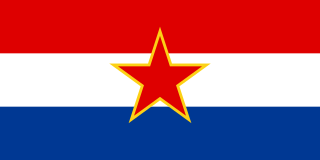 W
WThe Socialist Republic of Croatia, or SR Croatia, was a constituent republic and federated state of Yugoslavia and the nation state of Croats. By its constitution, modern-day Croatia is its direct continuation.
 W
WThe Socialist Republic of Macedonia, or SR Macedonia, commonly referred to as Socialist Macedonia or simply Macedonia, was one of the six constituent countries of the post-WWII Socialist Federal Republic of Yugoslavia, and a nation state of the Macedonians. After the transition of the political system to parliamentary democracy in 1990, the Republic changed its official name to Republic of Macedonia in 1991, and with the beginning of the breakup of Yugoslavia, it declared itself an independent country on 8 September 1991.
 W
WThe Socialist Republic of Montenegro, commonly referred to as Socialist Montenegro or simply Montenegro, was one of the six republics forming the Socialist Federal Republic of Yugoslavia and the nation state of the Montenegrins. It is a predecessor of the modern-day Montenegro.
 W
WThe Socialist Republic of Serbia, previously known as the People's Republic of Serbia, was one of the six constituent republics of the Socialist Federal Republic of Yugoslavia. Its formation was initiated in 1941, and achieved in 1944-1946, when it was established as a federated republic within Yugoslavia. In that form, it lasted until the constitutional reform in 1990-1992, when it was reconstituted, as the Republic of Serbia within the Federal Republic of Yugoslavia. It was the largest federated state within Yugoslavia, in terms of population and territory. Its capital, Belgrade, was also the federal capital of Yugoslavia.
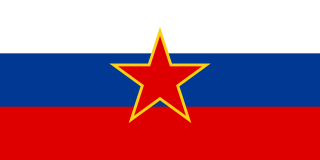 W
WThe Socialist Republic of Slovenia, commonly referred to as Socialist Slovenia or simply Slovenia, was one of the six federal republics forming the post-World War II country of Yugoslavia and the nation state of the Slovenes. It existed under various names from its creation on 29 November 1945 until 25 June 1991. In 1990, while the country was still a part of the Yugoslav federation, the League of Communists of Slovenia allowed for the establishment of other political parties, which led to the democratization of the country.
 W
WMartin Špegelj was a Croatian army general and politician who served as the second Defense Minister of Croatia and, later, the chief of staff of the newborn Croatian army and inspector-general of the army. His efforts to organize and equip the army from scratch were seen as instrumental in helping Croatia survive the first year of the Croatian War of Independence. Partly due to disagreements with president Franjo Tuđman, he retired in 1992, after the war froze with the permanent ceasefire at the end of 1991.
 W
WThe Ten-Day War, or the Slovenian War of Independence, was a brief conflict that followed Slovenia's declaration of independence from Yugoslavia on 25 June 1991. It was fought between the Slovenian Territorial Defence and the Yugoslav People's Army (JNA). It lasted from 27 June 1991 until 7 July 1991, when the Brioni Accords were signed. It marked the beginning of the Yugoslav Wars.
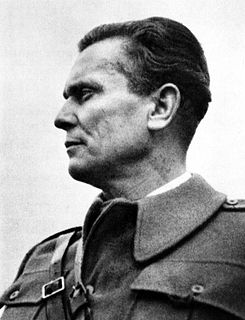 W
WThe Tito–Stalin Split, or Yugoslav–Soviet Split, was a conflict between the leaders of Yugoslavia and the Soviet Union, which resulted in Yugoslavia's expulsion from the Communist Information Bureau (Cominform) in 1948. This was the beginning of the Informbiro period, marked by poor relations with the USSR, that came to an end in 1955.
 W
WTito's Blue Train is a luxury train, once used by Josip Broz Tito, while president of the former Yugoslavia. It is now operated as a tourist attraction on the 476-kilometre (296 mi) Belgrade–Bar railway, between Belgrade, capital of Serbia, and Bar, a coastal town in Montenegro.
 W
WTitoism is a political philosophy most closely associated with Josip Broz Tito during the Cold War. It is characterized by a broad Yugoslav identity, a political separation from the Soviet Union, and leadership in the Non-Aligned Movement.
 W
WCar number plates in SFR Yugoslavia consisted of a two-letter district code that showed the place where the car carrying them was registered, followed by a red star and two groups of digits that could contain two or three letters, for example: BG 12-34, BG 123-45 or BG 123-456. The letter codes matched the municipalities of Yugoslavia:
 W
WThe office of the Vice President of the Presidency of the Socialist Federal Republic of Yugoslavia existed from the enactment of constitutional amendments establishing the position in 1971 until the dissolution of the country by 1992.
 W
WThe office of Vice President of the Socialist Federal Republic of Yugoslavia existed from April 1963 to June 1967. It was established by the new Yugoslav Constitution adopted on 7 April 1963. The first to serve in the role was Aleksandar Ranković who assumed office on 30 June 1963. Due to an affair involving wire-tapping of Yugoslav president and general secretary of the League of Communists Josip Broz Tito, Ranković was forced to resign from the Central Committee and from the vice presidency on 1 July 1966. He was subsequently replaced by Koča Popović two weeks later who served out the remainder of Ranković's four-year term. On 26 April 1967 new amendments to the 1963 constitution were approved which disestablished the vice presidency once Ranković and Popović's combined four-year term was up. The office ceased to exist on 30 June 1967.
 W
WYouth work actions were organized voluntary labor activities of young people in the Socialist Federal Republic of Yugoslavia. The actions were used to build public infrastructure such as roads, railways, and public buildings, as well as industrial infrastructure. The youth work actions were organized on local, republic, and federal levels by the Young Communist League of Yugoslavia, and participants were organized into youth work brigades, generally named after their town or a local national hero. Important projects built by youth work brigades include the Brčko-Banovići railway, the Šamac-Sarajevo railway, parts of New Belgrade, and parts of the Highway of Brotherhood and Unity, which stretches from northern Slovenia to southern Macedonia.
 W
WThe Socialist Federal Republic of Yugoslavia was one of the founding members of the Non-Aligned Movement. Belgrade, capital of Yugoslavia, was the host of the First Summit of the Non-Aligned Movement in early September 1961. City hosted the Ninth Summit as well in September of 1989.